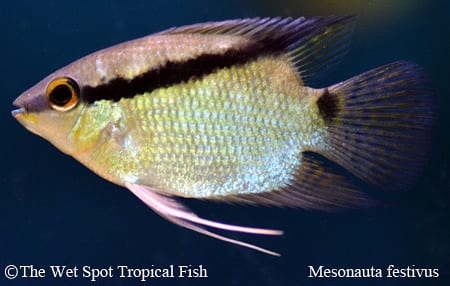Fishmas Time is Here
Fishmas Time is Here
Happiness and cheer! Whether you celebrate Christmas or not, here in America we can all appreciate this final festive benchmark before end of the year…not to mention, the extra days off from work. Even when you’re sharing your passion for a living, it’s nice to take some away to throw a couple snowballs, pick up a peppermint latte, and simply enjoy a myriad of winter festivities with loved ones. In the spirit of looking forward to the next few days, this week, we’ve chosen to share our merriest trio including Hypancistrus sp. “L201″, Luciocephalus aura, and Mesonauta egregius.
Scientific NameHypancistrus sp. L201
Common NameColombian Snowball Pleco
Temperature / pH78 to 86°F / 6.5 to 7.5 pH
Native LocationColombia
Preferred DietCarnivorous
Native ot the upper Rio Orinoco of Colombia, where it seldom snows, is Hypancistrus sp. “L201”. Also known as the “Colombian Snowball Pleco” this small catfish reaches about 4 inches in length and exhibits a dark body pocked with round white spots. A great addition to any warm-watered community tank, these plecos are generally jolly, and thrive alongside tetras, discus, corydoras, and apistos. Like with any family gathering, however, males tend to ‘bicker’ when in close quarters. If more than one individual is being kept, distinct territories, each with their own cave must be defined. Tank setups should include sandy substrate, rocks, driftwood, and caves formed from rock piles, PVC pipe, or bamboo. Carnivorous by nature, these plecos have reduced teeth compared to their algae-scraping loricariid ancestors, and should not be expected to consume tank algae. Diets should be comprised of meaty foods like dried discus food, bloodworm, and brine shrimp. Tank waters should be maintained with temperatures between 78 and 86°F, pH of 6.5 to 7.5, and hardness of 28 to 86 ppm.
Scientific NameLuciocephalus aura
Common NamePeppermint Pikehead
Temperature / pH72 to 79°F / 5.0 to 6.0 pH
Native LocationIndonesia
Preferred DietLive foods
Easily mistaken for a peppermint stick in the middle reaches of the swamps of Indonesia, is L. aura. Also known as “Peppermint Pikehead’, these long skinny fish with pointed heads reach about 4 inches in length and have lovely peppermint green stripe down their sides. Preferring forest swamp habitats, tanks should be densely planted including floating plants, peat substrate, and twigs and branches breaking the surface. In the wild, they are found along the surface water waiting to ambush prey they happen by. With the ability to unhinge their jaws, they can eat very large morsels for their size. In captivity, they should be kept with only their own kind, or with species of comparable size and temperament. It can be difficult to get this species to consume dead foods, and do best with regular live fish or shrimp meals. Tank waters should be soft and acidic with temperatures between 72 and 79°F, pH of 5.0 to 6.0, and hardness of 0 and 71 ppm.
Scientific NameMesonauta festivus
Common NameFestivum Cichlids
Temperature / pH75 to 82°F / 5.5 to 7.0 pH
Native LocationRio Orinoco
Preferred DietSmall invertebrates
Another festive fish hailing from the Rio Orinoco basin, M. egregius, is the embodiment of a particular secular holiday popularized by Seinfeld…oh wait…that’s Festivus, not “Festivum”. These “Festivum Cichlids” are 4-5 inch cichlids with disk-like body shapes and a roman-nose profile. Shifting between gold and green coloration based on their mood, with red fins, and a dark ornamental spotted stripe, these are the perfect Christmas fish. Due to their size, tanks should be at least 30 cm in depth and a minimum of 180 liters in capacity. Gregarious as juveniles, these fish pair off when they reach sexual maturity, at which point pairs will defend territories of about 16 inches from their nesting site. Peaceful toward most other species, optimal tankmates include tetras, barbs, and rasboras. Feeding on small invertebrates in the wild, they should be fed varied diets of flake, pellets, and live and frozen fare. Optimal water conditions include temperatures of 75 to 82°F, pH between 5.5 and 7.0, and hardness of 14 to 71 ppm.
It’s always Fishmas here at The Wet Spot. Call our experts today to find the best holiday companions. What better way to spend that Christmas loot burning holes in those pockets!


